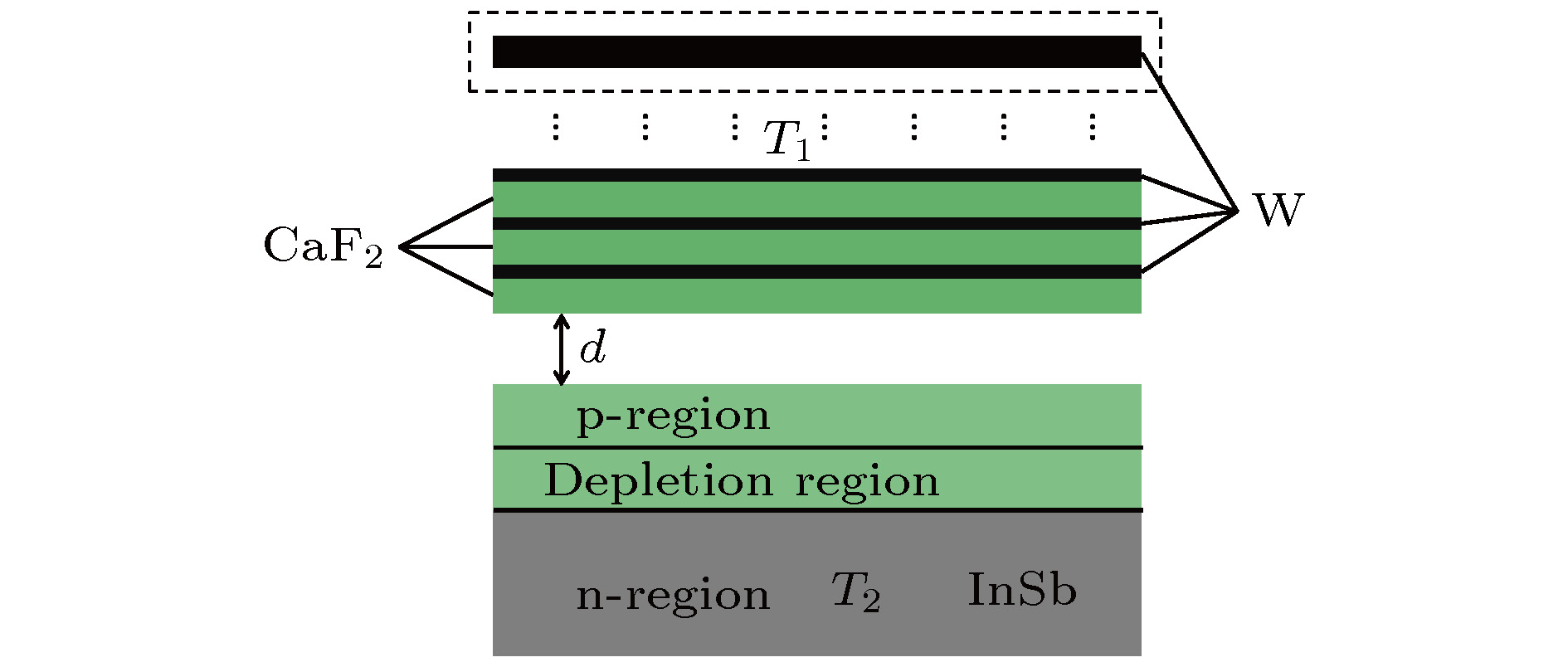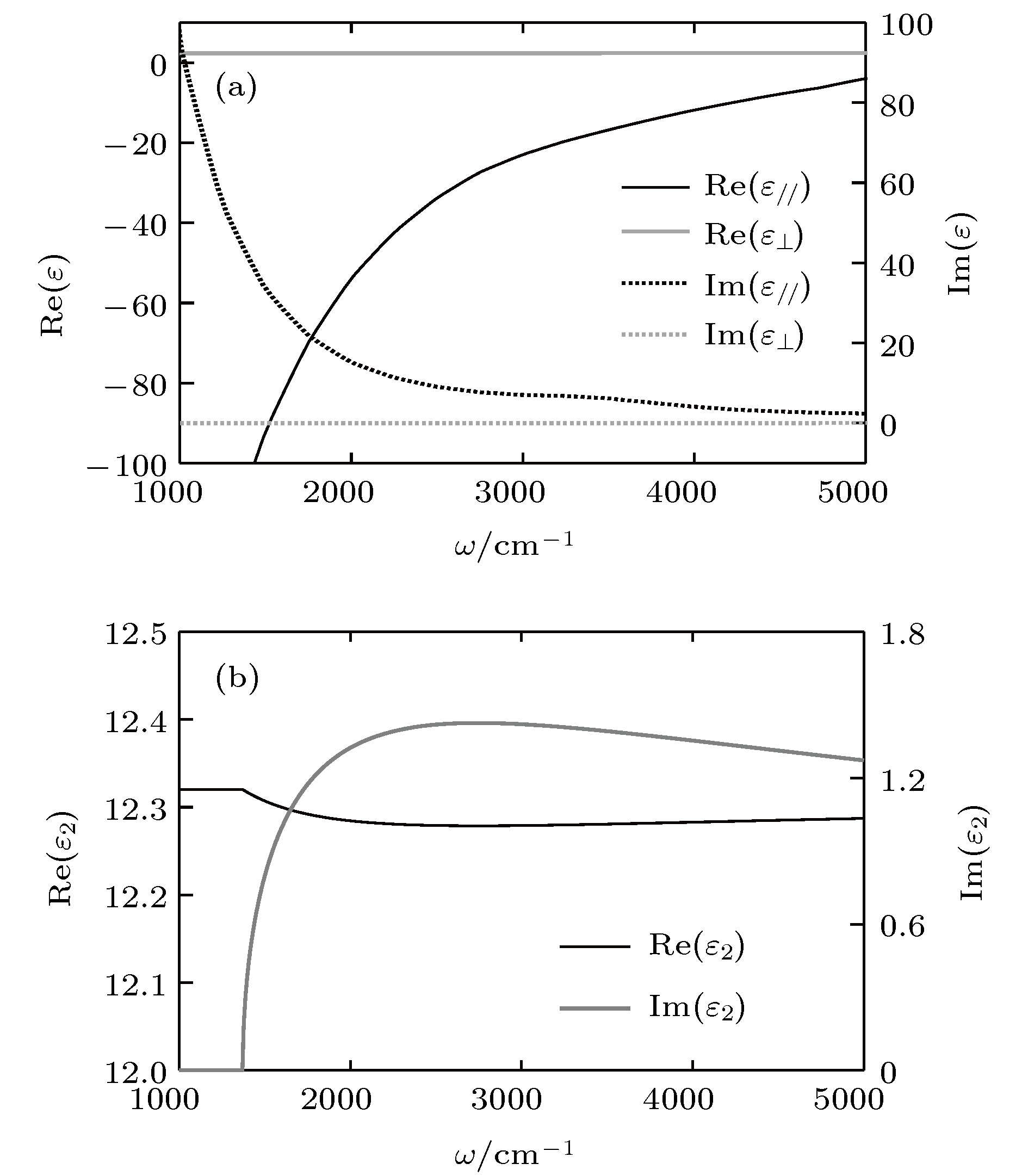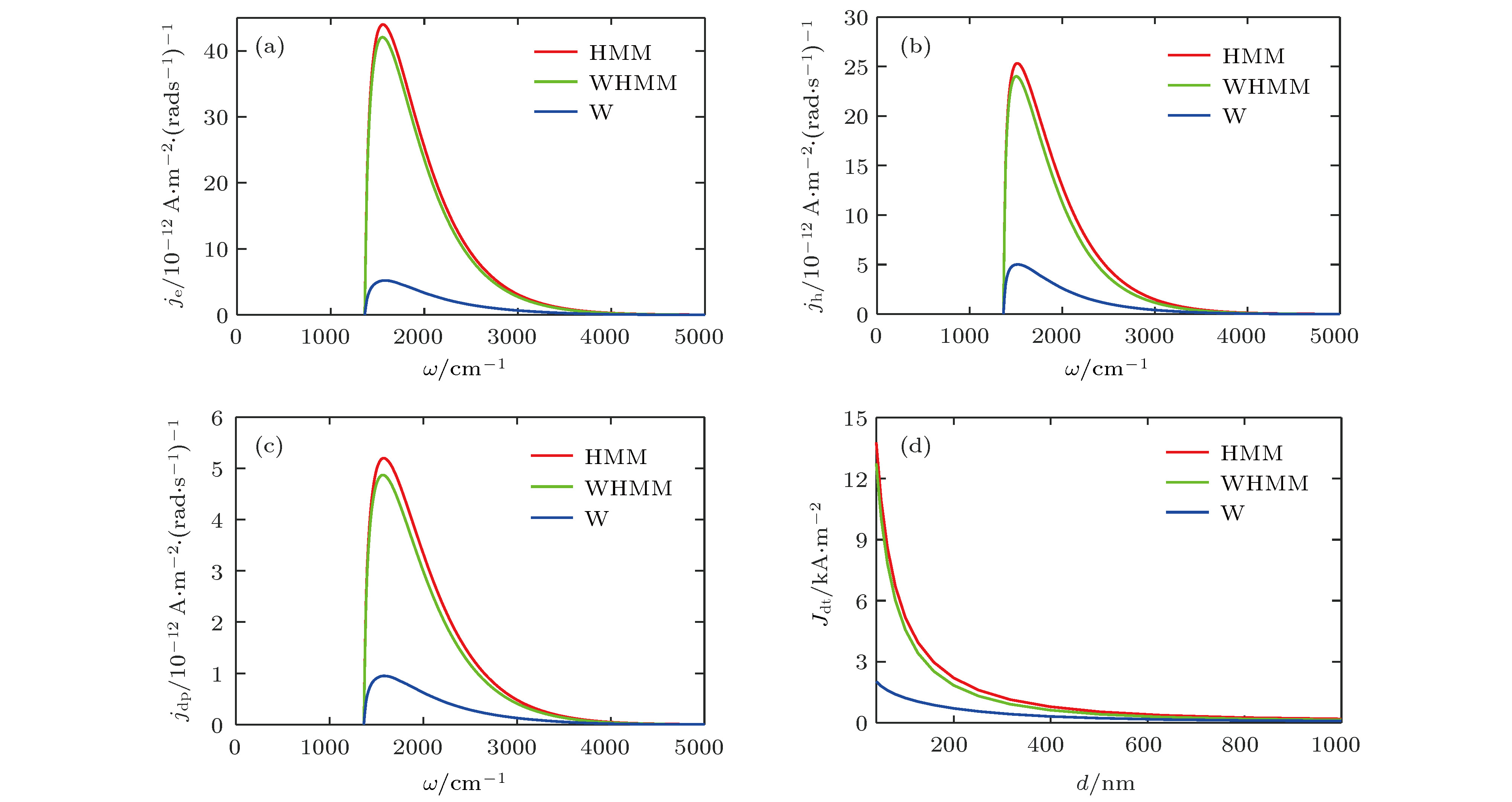-
基于近场热辐射的热光伏器件是一种极具应用前景的热电转换器件. 近场下由于倏逝波的隧穿作用, 可以获得远超黑体辐射的热流及热电功率, 此时辐射表面光子态密度是个关键因素. 本文提出了一种具有高表面态密度的CaF2/W多层膜人工双曲介质作为辐射器, 可以针对有限温度热源获得高效热电转化效果. 采用禁带宽度为0.17 eV的锑化铟p-n结作为接收端, 在200 K温度差和50 nm近场间隙下, 理论上计算获得了超过1 kW/m的高发电功率, 热电转化效率在11%以上, 显著高于热电材料的能量转换效率. 与纯钨热源情形相比, 双曲介质具有更高的倏逝波态密度, 有助于显著增强辐射热流与能量利用率. 进一步研究发现, 当多层膜双曲介质厚度超过140 nm时, 基底的影响已经可以忽略, 这对器件的实际制作非常有益. 相对于纳米线阵列或自然双曲介质, 本文提出的多层膜结构在制作和带宽上具有明显优势, 研究结果为近场热光伏的发展起到了促进作用.Thermophotovoltaic (TPV) device is a thermoelectric conversion method with great application prospects. In the far-field regime, the thermoelectric power is usually small due to the Planck blackbody radiation limit, but can be substantially enhanced in the near-field regime where evanescent waves will participate in the heat transfer by tunneling. In this aspect, the surface optical density of state is a key factor that will determine the transfer conversion of thermal photons. Plasmonic or phononic resonance materials have been discussed in the literature to acquire large heat flux. Besides, metamaterial is another way to pursue the design freedoms for the same purpose. In this work, we propose a [CaF2/W]n multilayer based infrared hyperbolic metamaterial (HMM) with high surface density of states as an emitter of a high-performance TPV cell made of an InSb p-n junction (energy bandgap = 0.17 eV). The effective medium theory (EMT) is utilized to describe the electromagnetic behavior of the HMM. The near-field heat flux is calculated based on electrodynamic wave theory and Green's function method, and the photocurrent of thermophotovoltaic device is derived using diffusion equation for semiconductor. For comparison, we design three different radiators, i.e. tungsten film (W), [GaF2/W]n multilayer hyperbolic metamaterial (HMM), and tungsten-grounded HMM (WHMM). Compared with the pure tungsten radiator, the artificial structure exhibits the hyperbolic dispersion characteristic in a wide frequency range, which gives rise to a higher local density of states, in particular in the hyperbolic-to-elliptic spectral transition region. As a result, the radiation power and the energy conversion efficiency are greatly enhanced, which are more easily realized by a matched emission band achieved by the structural design. We find that the thermophotovoltaic device with WHMM radiator has a similar power and conversion efficiency to that with the HMM radiator. The influence of the substrate can be ignored when the hyperbolic metamaterial is thicker than 140 nm, very beneficial to the actual fabrication of the device. By our system, with multilayer hyperbolic metamaterial (HMM) radiator, a high electric power >1 W/m2 and a conversion efficiency about 11% can be obtained at a bias temperature of 200 K and a 100 nm vacuum gap. Compared with nanowire arrays or natural hyperbolic material, the multilayer structure proposed in this paper has obvious advantages in bandwidth and manufacturing and may find important applications in near-field thermophotovoltaic device and other relevant areas.
-
Keywords:
- near-field thermal radiation /
- hyperbolic metamaterial /
- thermophotovoltaic cell /
- heat recycling
[1] Hoffert M I, Caldeira K, Jain A K, Haites E F, Harvey L D D, Potter S D, Schlesinger M E, Schneider S H, Watts R G, Wigley T M L, Wuebbles D J 1998 Nature 395 881
 Google Scholar
Google Scholar
[2] BCS, Inc 2008 Waste Heat Recovery. Technology and Opportunities in U.S. Industry (Hinsdale: BCS) pp6–19
[3] Liu W S, Jie Q, Kim H S, Ren Z F 2015 Acta Mater. 87 357
 Google Scholar
Google Scholar
[4] Alam H, Ramakrishna S 2013 Nano Energy 2 190
 Google Scholar
Google Scholar
[5] Chan W R, Bermel P, Pilawa-Podgurski R C N, Marton C H, Jensen K F, Senkevich J J, Joannopoulos J D, Soljacic M, Celanovic I 2013 PNAS 110 5309
 Google Scholar
Google Scholar
[6] Bierman D M, Lenert A, Chan W R, Bhatia B, Celanovic I, Soljacic M, Wang E N 2016 Nat. Energy 1 16068
 Google Scholar
Google Scholar
[7] Whale M D, Cravalho E G 2002 IEEE Trans. Energy Convers. 17 130
 Google Scholar
Google Scholar
[8] Yang J, Du W, Su Y, Fu Y, Gong S, He S, Ma Y 2018 Nat. Commun. 9 4033
 Google Scholar
Google Scholar
[9] Thomas N H, Sherrott M C, Broulliet J, Atwater H A, Minnich A J 2019 Nano Lett. 19 3898
 Google Scholar
Google Scholar
[10] Zhao B, Guizal B, Zhang Z M, Fan S, Antezza M 2017 Phys. Rev. B 95 245437
 Google Scholar
Google Scholar
[11] Zwol P J, Thiele S, Berger C, Heer W A, Chevrier J 2012 Phys. Rev. Lett. 109 264301
 Google Scholar
Google Scholar
[12] Liu B, Shen S 2013 Phys. Rev. B 87 115403
 Google Scholar
Google Scholar
[13] Jin S, Lim M, Lee S S, Lee B J 2016 Opt. Express 24 A635
 Google Scholar
Google Scholar
[14] Shi J, Liu B, Li P, Ng L Y, Shen S 2015 Nano Lett. 15 1217
 Google Scholar
Google Scholar
[15] Park K, Basu S, King W P, Zhang Z M 2008 J. Quant. Spectrosc. Radiat. Transfer 109 305
 Google Scholar
Google Scholar
[16] 于海童, 刘东, 杨震, 段远源 2018 67 024209
 Google Scholar
Google Scholar
Yu H T, Liu D, Yang Z, Duan Y Y 2018 Acta Phys. Sin. 67 024209
 Google Scholar
Google Scholar
[17] Zhao B, Santhanam P, Chen K, Buddhiraju S, Fan S 2018 Nano Lett. 18 5224
 Google Scholar
Google Scholar
[18] Fiorino A, Zhu L, Thompson D, Mittapally R, Reddy P, Meyhofer E 2018 Nat. Nanotechnol. 13 806
 Google Scholar
Google Scholar
[19] Papadakis G T, Buddhiraju S, Zhao Z, Zhao B, Fan S 2020 Nano Lett. 20 1654
 Google Scholar
Google Scholar
[20] Datas A, Vaillon R 2019 Appl. Phys. Lett. 114 133501
 Google Scholar
Google Scholar
[21] Malitson I H 1963 Appl. Opt. 2 1103
 Google Scholar
Google Scholar
[22] Liu X L, Zhang R Z, Zhang Z M 2014 Int. J. Heat Mass Transfer 73 389
 Google Scholar
Google Scholar
[23] Biehs S A, Tschikin M, Messina R, Ben-Abdallah P 2013 Appl. Phys. Lett. 102 131106
 Google Scholar
Google Scholar
[24] Lim M K, Jin S K, Lee S S, Lee B J 2015 Opt. Express 23 A240
 Google Scholar
Google Scholar
[25] Poddubny A, Iorsh I, Belov P, Kivshar Y 2013 Nat. Photonics 7 958
 Google Scholar
Google Scholar
[26] Liu X L, Bright T J, Zhang Z M 2014 J. Heat Transfer 136 092703
 Google Scholar
Google Scholar
[27] Zhang R Z, Zhang Z M 2017 J. Quant. Spectrosc. Radiat. Transfer 197 132
 Google Scholar
Google Scholar
[28] Volokitin A I, Persson B N J 2007 Rev. Mod. Phys. 79 1291
 Google Scholar
Google Scholar
[29] Volokitin A I, Persson B N J 1999 J. Phys. Condens. Matter 11 345
 Google Scholar
Google Scholar
[30] Vaillon R, Robin L, Muresan C, Ménézo C 2006 Int. J. Heat Mass Transfer 49 4454
 Google Scholar
Google Scholar
[31] Guo Y, Newman W, Cortes C L, Jacob Z 2012 ADOP 2012 1
[32] Francoeur M, Vaillon R, Mengüç M P 2011 IEEE Trans. Energy Convers. 26 686
 Google Scholar
Google Scholar
[33] Lang S, Tschikin M, Biehs S A, Petrov A Y, Eich M 2014 Appl. Phys. Lett. 104 121903
 Google Scholar
Google Scholar
[34] Laroche M, Carminati R, Greffet J 2006 J. Appl. Phys. 100 063704
 Google Scholar
Google Scholar
[35] Baldasaro P F, Raynolds J E, Charache G W, DePoy D M, Ballinger C T, Donovan T, Borrego J M 2001 J. Appl. Phys. 89 3319
 Google Scholar
Google Scholar
[36] Bright T J, Wang L P, Zhang Z M 2014 J. Heat Transfer 136 062701
 Google Scholar
Google Scholar
-
图 5 间距为d = 50 nm时的电流谱 (a) p区
$ {j}_{\mathrm{e}}\left(\omega \right) $ ; (b) n区$ {j}_{\mathrm{h}}\left(\omega \right) $ ; (c) 耗尽层内$ {j}_{\mathrm{d}\mathrm{p}}\left(\omega \right) $ ; (d) p-n结内的总电流大小$ {j}_{\mathrm{t}} $ 随间距的变化Fig. 5. Current density spectrum in the (a) p-region, (b) n-region, and (c) depletion region; (d) total current with respect to the vacuum gap width.
参数 p 区 n 区 载流子浓度/cm–3 NA = 1019 ND = 1019 扩散系数/cm2·s–1 De = 186 Dh = 5.21 弛豫时间/ns τe = 1.45 τh = 1.81 复合速率/m·s–1 up =104 un = 0 区域长度/μm Lp = 0.4 Ln = 10 -
[1] Hoffert M I, Caldeira K, Jain A K, Haites E F, Harvey L D D, Potter S D, Schlesinger M E, Schneider S H, Watts R G, Wigley T M L, Wuebbles D J 1998 Nature 395 881
 Google Scholar
Google Scholar
[2] BCS, Inc 2008 Waste Heat Recovery. Technology and Opportunities in U.S. Industry (Hinsdale: BCS) pp6–19
[3] Liu W S, Jie Q, Kim H S, Ren Z F 2015 Acta Mater. 87 357
 Google Scholar
Google Scholar
[4] Alam H, Ramakrishna S 2013 Nano Energy 2 190
 Google Scholar
Google Scholar
[5] Chan W R, Bermel P, Pilawa-Podgurski R C N, Marton C H, Jensen K F, Senkevich J J, Joannopoulos J D, Soljacic M, Celanovic I 2013 PNAS 110 5309
 Google Scholar
Google Scholar
[6] Bierman D M, Lenert A, Chan W R, Bhatia B, Celanovic I, Soljacic M, Wang E N 2016 Nat. Energy 1 16068
 Google Scholar
Google Scholar
[7] Whale M D, Cravalho E G 2002 IEEE Trans. Energy Convers. 17 130
 Google Scholar
Google Scholar
[8] Yang J, Du W, Su Y, Fu Y, Gong S, He S, Ma Y 2018 Nat. Commun. 9 4033
 Google Scholar
Google Scholar
[9] Thomas N H, Sherrott M C, Broulliet J, Atwater H A, Minnich A J 2019 Nano Lett. 19 3898
 Google Scholar
Google Scholar
[10] Zhao B, Guizal B, Zhang Z M, Fan S, Antezza M 2017 Phys. Rev. B 95 245437
 Google Scholar
Google Scholar
[11] Zwol P J, Thiele S, Berger C, Heer W A, Chevrier J 2012 Phys. Rev. Lett. 109 264301
 Google Scholar
Google Scholar
[12] Liu B, Shen S 2013 Phys. Rev. B 87 115403
 Google Scholar
Google Scholar
[13] Jin S, Lim M, Lee S S, Lee B J 2016 Opt. Express 24 A635
 Google Scholar
Google Scholar
[14] Shi J, Liu B, Li P, Ng L Y, Shen S 2015 Nano Lett. 15 1217
 Google Scholar
Google Scholar
[15] Park K, Basu S, King W P, Zhang Z M 2008 J. Quant. Spectrosc. Radiat. Transfer 109 305
 Google Scholar
Google Scholar
[16] 于海童, 刘东, 杨震, 段远源 2018 67 024209
 Google Scholar
Google Scholar
Yu H T, Liu D, Yang Z, Duan Y Y 2018 Acta Phys. Sin. 67 024209
 Google Scholar
Google Scholar
[17] Zhao B, Santhanam P, Chen K, Buddhiraju S, Fan S 2018 Nano Lett. 18 5224
 Google Scholar
Google Scholar
[18] Fiorino A, Zhu L, Thompson D, Mittapally R, Reddy P, Meyhofer E 2018 Nat. Nanotechnol. 13 806
 Google Scholar
Google Scholar
[19] Papadakis G T, Buddhiraju S, Zhao Z, Zhao B, Fan S 2020 Nano Lett. 20 1654
 Google Scholar
Google Scholar
[20] Datas A, Vaillon R 2019 Appl. Phys. Lett. 114 133501
 Google Scholar
Google Scholar
[21] Malitson I H 1963 Appl. Opt. 2 1103
 Google Scholar
Google Scholar
[22] Liu X L, Zhang R Z, Zhang Z M 2014 Int. J. Heat Mass Transfer 73 389
 Google Scholar
Google Scholar
[23] Biehs S A, Tschikin M, Messina R, Ben-Abdallah P 2013 Appl. Phys. Lett. 102 131106
 Google Scholar
Google Scholar
[24] Lim M K, Jin S K, Lee S S, Lee B J 2015 Opt. Express 23 A240
 Google Scholar
Google Scholar
[25] Poddubny A, Iorsh I, Belov P, Kivshar Y 2013 Nat. Photonics 7 958
 Google Scholar
Google Scholar
[26] Liu X L, Bright T J, Zhang Z M 2014 J. Heat Transfer 136 092703
 Google Scholar
Google Scholar
[27] Zhang R Z, Zhang Z M 2017 J. Quant. Spectrosc. Radiat. Transfer 197 132
 Google Scholar
Google Scholar
[28] Volokitin A I, Persson B N J 2007 Rev. Mod. Phys. 79 1291
 Google Scholar
Google Scholar
[29] Volokitin A I, Persson B N J 1999 J. Phys. Condens. Matter 11 345
 Google Scholar
Google Scholar
[30] Vaillon R, Robin L, Muresan C, Ménézo C 2006 Int. J. Heat Mass Transfer 49 4454
 Google Scholar
Google Scholar
[31] Guo Y, Newman W, Cortes C L, Jacob Z 2012 ADOP 2012 1
[32] Francoeur M, Vaillon R, Mengüç M P 2011 IEEE Trans. Energy Convers. 26 686
 Google Scholar
Google Scholar
[33] Lang S, Tschikin M, Biehs S A, Petrov A Y, Eich M 2014 Appl. Phys. Lett. 104 121903
 Google Scholar
Google Scholar
[34] Laroche M, Carminati R, Greffet J 2006 J. Appl. Phys. 100 063704
 Google Scholar
Google Scholar
[35] Baldasaro P F, Raynolds J E, Charache G W, DePoy D M, Ballinger C T, Donovan T, Borrego J M 2001 J. Appl. Phys. 89 3319
 Google Scholar
Google Scholar
[36] Bright T J, Wang L P, Zhang Z M 2014 J. Heat Transfer 136 062701
 Google Scholar
Google Scholar
计量
- 文章访问数: 9155
- PDF下载量: 120
- 被引次数: 0














 下载:
下载:










